Convair B-58 Hustler
| B-58 Hustler | |
|---|---|
._Photo_taken_on_June_29%2C_1967_061101-F-1234P-019.jpg) | |
| Convair B-58A in flight, June 1967 | |
| Role | Supersonic strategic bomber |
| Manufacturer | Convair |
| First flight | 11 November 1956 |
| Introduction | 15 March 1960 |
| Retired | 31 January 1970 |
| Status | Retired |
| Primary user | United States Air Force |
| Number built | 116 |
| Unit cost | |
| Variants | Convair Model 58-9 |
The Convair B-58 Hustler was the first operational jet bomber capable of Mach 2 flight.[2] The aircraft was designed by Convair engineer Robert H. Widmer and developed for the United States Air Force for service in the Strategic Air Command (SAC) during the 1960s.[3] It used a delta wing, which was also employed by Convair fighters such as the F-102, with four General Electric J79 engines in pods under the wing. It carried five nuclear weapons; four on pylons under the wings, and one nuclear weapon and fuel in a combination bomb/fuel pod under the fuselage, rather than in an internal bomb bay.
Replacing the Boeing B-47 Stratojet medium bomber, it was originally intended to fly at high altitudes and supersonic speeds to avoid Soviet fighters. The B-58 received a great deal of notoriety due to its sonic boom, which was often heard by the public as it passed overhead in supersonic flight.[4]
The introduction of highly accurate Soviet surface-to-air missiles forced the B-58 into a low-level penetration role that severely limited its range and strategic value, and it was never employed to deliver conventional bombs. This led to a brief operational career between 1960 and 1970 when the B-58 was succeeded by the smaller, swing-wing FB-111A.[5]
Design and development

The genesis of the B-58 program came in February 1949, when a Generalized Bomber Study (GEBO II) had been issued by the Air Research and Development Command (ARDC) at Wright-Patterson AFB, Ohio, for the development of a supersonic, long range, bombardment aviation platform. The proposed bomber's design and development was to begin less than two years after sustained supersonic flight had successfully been achieved.[6] A number of contractors submitted bids to perform the generalized study (that hopefully would lead to a development contract) including Boeing, Convair, Curtiss, Douglas, Martin and North American Aviation.
Convair, building on its experience in earlier delta-wing fighters, beginning with the XF-92A, a series of GEBO II designs were developed, initially studying swept and semi-delta configurations, but settling on the delta wing planform. The delta planform had good internal volume for support systems and fuel; plus a low wing loading (for airframe size), that permitted supersonic flight in the mid-stratosphere (50 - 70,000 feet). The final Convair proposal, coded FZP-110, was a radical two-place, delta wing bomber design powered by General Electric J53 engines. The performance estimates included a 1,000 mph (1,600 km/h; 870 kt) speed and a 3,000 statute mile (4,800 km; 2,600 nmi) range.[6]
_061101-F-1234P-016.jpg)
The USAF chose Boeing (MX-1712) and Convair to proceed to a Phase 1 study. The Convair MX-1626 evolved further into a more refined proposal redesignated the MX-1964. In December 1952, the Air Force selected the MX-1964 as the winner of the design competition[7] to meet the newly proposed SAB-51 (Supersonic Aircraft Bomber) and SAR-51 (Supersonic Aircraft Reconnaissance), the first General Operational Requirement (GOR) worldwide for supersonic bombers. In February 1953, the Air Force issued a contract for development of Convair's design.[8]
The resulting B-58 design was the first "true" USAF supersonic bomber program. The Convair design was based on a delta wing with a leading-edge sweep of 60° with four General Electric J79-GE-1 turbojet engines, capable of flying at twice the speed of sound. Although its large wing made for relatively low wing loading, it proved to be surprisingly well suited for low-altitude, high-speed flight. It seated three (pilot, bombardier/navigator, and defensive systems operator) in separated tandem cockpits. Later versions gave each crew member a novel ejection capsule that made it possible to eject at an altitude of 70,000 ft (21,000 m) at speeds up to Mach 2 (1,320 mph/2,450 km/h). Unlike standard ejection seats of the period, a protective clamshell would enclose the seat and the control stick with an attached oxygen cylinder, allowing the pilot to continue to fly even "turtled up" and ready for immediate egress. The capsule would float, and the crewmember could open the clamshell, using it as a life raft.[9][10] In an unusual test program, live bears and chimpanzees were successfully used to test the ejection system.[11] The XB-70 would use a similar system (though using capsules of a different design).

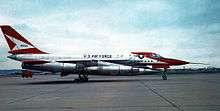
Because of heat generated at Mach 2 cruise, not only the crew compartment, but the wheel wells and electronics bay were pressurized and air conditioned. The B-58 utilized one of the first extensive applications of aluminum honeycomb panels, which bonded outer and inner aluminum skins to a honeycomb of aluminum and fiberglass.[12]
The pilot's cockpit was fairly conventional for a large multiengine aircraft.[13] The electronic controls were ambitious and advanced for the day. The navigator and DSO's cockpits featured wraparound dashboards with warning lights and buttons, and automatic voice messages and warnings from a tape system were audible through the helmet sets. Research during the era of all-male combat aircraft assignments revealed that a woman's voice was more likely to gain the attention of young men in distracting situations. Nortronics Division of Northrop Corporation selected actress and singer Joan Elms to record the automated voice warnings. To the men flying the B-58, the voice was known as "Sexy Sally."[14][15]
Weapons systems
The Sperry AN/ASQ-42 bombing/navigation system combined a sophisticated inertial navigation system with the KS-39 Star tracker (astro-inertial navigation system) to provide heading reference, the AN/APN-113 Doppler radar to provide ground speed and windspeed data, a search radar to provide range data for bomb release and trajectory, and a radar altimeter.[16] The AN/ASQ-42 was estimated to be 10 times more accurate than any previous bombing/navigation system.[16]
Defensive armament consisted of a single 20 mm (0.79 in) T-171E-3 rotary cannon with 1,200 rounds of ammunition in a radar-aimed tail barbette.[16][17] It was remotely controlled through the Emerson MD-7 automated radar fire-control system only requiring the DSO to lock-on a selected target blip on his scope and then fire the gun; the system computing all aiming, velocity or heading differential, and range compensation.[16] Offensive armament typically consisted of a single nuclear weapon, along with fuel tanks, in a streamlined MB-1C pod under the fuselage. Incurable difficulties with fuel leakage resulted in the replacement of the MB-1C with the TCP (Two Component Pod), which placed the nuclear weapon in an upper section while the lower fuel component could be independently jettisoned.[18] This had the added benefit of allowing the pilot to "clean up" the aircraft for fuel efficiency or in case of emergency, while still retaining the (somewhat) more slim weapon.
The first prototype, serial number 55-660, was completed in late August 1956.[19] The first flight took place in November 1956.[20] A difficult and protracted flight test program involving 30 aircraft continued until April 1959.[21] The final B-58 was delivered in October 1962.[21]
From 1961 to 1963, the B-58 was retrofitted with two tandem stub pylons under each wing root, adjacent to the centreline pod,[22] for B43 or B61 nuclear weapons for a total of five nuclear weapons per aircraft. Although the USAF explored the possibility of using the B-58 for the conventional strike role, it was never equipped for carrying or dropping conventional bombs in service. A photo reconnaissance pod, the LA-331, was also fielded. Several other specialized pods for ECM or an early cruise missile were considered, but not adopted. The late 1950s High Virgo air-launched ballistic missile was designed to be launched from the B-58 with four test launches of the High Virgo carried out by a B-58 to determine ballistic missile and anti-satellite weapon system capability.[23]
Operational history

The B-58 crews were chosen from other strategic bomber squadrons. Due to some characteristics of delta-winged aircraft, new pilots used the Convair F-102 Delta Dagger as a conversion trainer, before moving to the TB-58A trainer.[24] The B-58 was difficult to fly and its three-man crews were constantly busy, but its performance was exceptional. A lightly loaded Hustler would climb at nearly 46,000 ft/min (235 m/s).[25] In addition to its much smaller weapons load and more limited range than the Boeing B-52 Stratofortress, the B-58 had also been extremely expensive to acquire.
Excessive program expenditure
Through FY 1961, the total cost of the B-58 program was $3 billion.[26][27] A highly complex aircraft, it also required considerable maintenance, much of which required specialized equipment and ground personnel. For comparison, the average maintenance cost per flying hour for the B-47 was $361, for the B-52 it was $1,025 and for the B-58 it was $1,440.[28] The B-58 also cost three times as much to operate as the B-52.[29] The cost of maintaining and operating the two operational B-58 wings equaled that of six wings of B-52s.[30] This included special detailed maintenance for the nose landing gear, which retracted in a complicated fashion to avoid the center payload. Further, compounding this, the B-58 had an unfavorably high accident rate: 26 B-58 aircraft were lost in accidents, 22.4% of total production. The SAC senior leadership had been dubious about the aircraft type from the beginning, although its crews eventually became enthusiastic about the aircraft. General Curtis LeMay was never satisfied with the bomber and after a flight in one declared that it was too small, far too expensive to maintain in combat readiness and required an excessive number of aerial refuelings to complete a mission.[31] Although the high altitude ferry range of the B-58 was better than the B-47, the lack of forward basing resulted in a requirement for more KC-135 tanker support.[32][33]
Adverse flight characteristics
While its performance and design were exceptional and appreciated, it was never easy to fly. This was caused by the 60° leading edge sweepback of its wing and was inherent in these types of delta wing platforms. It required a much higher angle of attack than a conventional aircraft, up to 9.4° at Mach 0.5 at low altitudes. If the angle of attack was too high, in excess of 17°, the bomber could pitch up and enter a spin. Several factors could prevent a successful recovery: if the pilot applied elevon, if the center of gravity was not correctly positioned, or if the spin occurred below 15,000 feet (4,600 metres), recovery might not be possible. The B-58 also had stall characteristics that were not conventional. If the nose was elevated, the bomber maintained forward motion without pitching down. Unless large amounts of power were applied, the descent rate increased rapidly.[30] Another problem pilots faced was called "fuel stacking" and took place when the B-58 accelerated or decelerated. It was due to fuel moving in the tanks and causing sudden changes in the center of gravity. This could cause the aircraft to pitch or bank and subsequently lose control.[34] The B-58 was very difficult to safely recover from the loss of an engine at supersonic cruise due to differential thrust.
The plane had very unusual takeoff requirements, with a 14° angle of attack needed for the rotation at about 203.5 knots (376.9 km/h; 234.2 mph) for a 150,000 pound combat weight.[35] This poor takeoff performance was also evident with the high landing speed that necessitated a drogue parachute for braking.
Operational wings and retirement
Two SAC bomb wings operated the B-58 during its operational service: the 43d Bombardment Wing, based at Carswell AFB, Texas from 1960 to 1964, and Little Rock AFB, Arkansas from 1964 to 1970; and the 305th Bombardment Wing, based at Bunker Hill AFB (later Grissom AFB), Indiana from 1961 to 1970. The 305th also operated the B-58 combat crew training school (CCTS), the predecessor of the USAF's current formal training units (FTUs).

By the time the early problems had largely been resolved and SAC interest in the bomber had solidified, Secretary of Defense Robert McNamara decided that the B-58 was not going to be a viable weapon system.[36] It was during the B-58's introduction that high-altitude Soviet surface-to-air missiles (SAM) became a viable threat, especially the SA-2 Guideline, a SAM system the Soviet Union extensively deployed. The "solution" to this problem was to fly at low altitudes, minimizing the radar line-of-sight and reducing exposure time.
Because of the denser air at low altitudes, the B-58 could not fly at supersonic speeds and its moderate range was reduced further, thereby negating the high-speed performance the design paid so dearly for. In late 1965, Secretary McNamara ordered the B-58's retirement by 1970. Despite efforts of the Air Force to earn a reprieve, the phaseout proceeded on schedule. The last B-58s were retired in January 1970 and placed in storage with the Military Aircraft Storage and Disposition Center (MASDC) at Davis-Monthan Air Force Base. The fleet survived until 1977, when nearly all remaining aircraft were sold to Southwestern Alloys for disposal.[37][38] The B-58 as a weapons system was replaced by the FB-111A, designed for low-altitude attack, more flexible with the carriage of conventional weapons, and less expensive to produce and maintain.
A total of 116 B-58s were produced: 30 trial aircraft and 86 production B-58A models. Most of the trial aircraft were later upgraded to operational standard. Eight were equipped as TB-58A training aircraft.
Due to B-58 pilots being the only US Air Force pilots experienced in long duration supersonic flight, several former Hustler crew members were selected to fly the Lockheed SR-71 Blackbird at the start of the program by Colonel Douglas Nelson. Thomas B. Estes and Dewain C. Vick[39] were eventually awarded both the Harmon and Mackay Trophies after they set a new world supersonic distance record, flying an SR-71 over 15,000 miles in just 10 hours and 30 minutes. [40]
Test aircraft
A number of B-58s were used for special trials. One was specially modified to test the Hughes radar system intended for the Lockheed YF-12 interceptor and the North American F-108 Rapier, which had an extended nose to accommodate the radar and was nicknamed "Snoopy" (see Aircraft on Display). Several improved (and usually enlarged) variants, named B-58B and B-58C by the manufacturer, were proposed but never built.
World records
The B-58 set 19 world speed records, including coast-to-coast records, and one for the longest supersonic flight in history. In 1963, it went from Tokyo to London (via Alaska), a distance of 8,028 miles (12,920 km) in 8 hours, 35 minutes, 20.4 seconds, averaging 938 miles per hour (1,510 kilometres per hour). As of 2016, this record still stands.[41][42] The aircraft was serving in an operational unit, and had not been modified in any way besides being washed and waxed. One of the goals of the flight was to push the limit of its new honeycomb construction technique. The speed of the flight was limited only by the speed at which they believed the honeycomb panels would delaminate, although one of the afterburners malfunctioned and the last hour of the flight was continued at subsonic speed. This reduced the average speed to roughly Mach 1.5, despite most of the flight being at Mach 2.[43][44] This B-58 was called "Greased Lightning" - the codename for the record attempt.
Some of the record winning aerospace trophies the B-58 won were the Bleriot trophy, the Thompson trophy, the Mackay trophy, the Bendix trophy and the Harmon trophy.[45]
Singer John Denver's father, Lt Colonel Henry J. Deutschendorf, Sr., USAF, held several speed records as a B-58 pilot.[46]
Variants
- XB-58: Prototype; two built.
- YB-58A: Pre-production aircraft, 11 built.
- B-58A: Three-seat medium-range strategic bomber aircraft, 86 built.
- TB-58A: Training aircraft, eight conversions from YB-58A.
- NB-58A: This designation was given to a YB-58A, which was used for testing the J93 engine. The engine was originally intended for the North American XB-70 Valkyrie Mach 3 bomber.
- RB-58A: Variant with ventral reconnaissance pod, 17 built.
- B-58B: Unbuilt version. SAC planned to order 185 of these improved bombers which had uprated J79-GE-9 engines, a stretched fuselage for extra fuel capacity, canards and could carry conventional weapons.[34][47] A prototype B-58B was ordered (S/N 60-1109), but the entire project was canceled before construction began, due to budgetary considerations.[48] The B variant was also planned to be the "mothership" for a Mach 4 parasite called the FISH (for First Invisible Super Hustler). Because It was to be faster and larger than the B-58A, it could carry the FISH instead of the external pod. At an altitude of at least 35,000 feet (11,000 metres) at speeds in excess of Mach 2 the FISHs three ramjet engines could be started.[49] The Super Hustler would then disengage from the B-58B and climb up to 90,000 feet (27,000 metres) and accelerate to Mach 4.2 to complete its mission.[50][51]
- B-58C: Unbuilt version. Enlarged version with more fuel and 32,500 lbf (145 kN) J58, the same engine used on the Lockheed SR-71. Design studies were conducted with two and four engine designs, the C model had an estimated top speed approaching Mach 3, a supersonic cruise capability of approximately Mach 2, and a service ceiling of about 70,000 ft (21,300 m) along with the capability of carrying conventional bombs. Convair estimated maximum range at 5,200 nautical miles (6,000 mi; 9,600 km). The B-58C was proposed as a lower cost alternative to the North American XB-70. As enemy defenses against high-speed, high-altitude penetration bombers improved, the value of the B-58C diminished and the program was canceled in early 1961.[52]
Operators

- 43d Bombardment Wing - Carswell AFB, Texas (1960-1964); Little Rock AFB, Arkansas (1964-1970)
- 63d Bombardment Squadron, Medium
- 64th Bombardment Squadron, Medium
- 65th Bombardment Squadron, Medium
- 3958th Operational Test and Evaluation Squadron (1958-1960)
- 305th Bombardment Wing - Bunker Hill (later Grissom AFB), Indiana (1961-1970)
- 364th Bombardment Squadron, Medium
- 365th Bombardment Squadron, Medium
- 366th Bombardment Squadron, Medium
- Air Force Flight Test Center - Edwards AFB, California (1956-58)
- 6592d Test Squadron
Aircraft on display

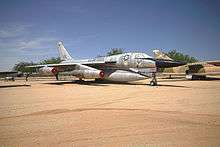
Today there are eight B-58 survivors:[53][54]
- TB-58A
- 55-0663 - Grissom Air Museum, Grissom Air Reserve Base (former Bunker Hill AFB/former Grissom AFB), Peru, Indiana. This is the oldest remaining aircraft and the fourth B-58 built.[55]
- 55-0668 - Little Rock Air Force Base in Jacksonville, Arkansas.[56]
- YB-58A
- 55-0665 (Snoopy) - Edwards Air Force Base, California. This aircraft sits derelict as a photo target on Edwards AFB's photo range.[57]
- 55-0666 - Octave Chanute Aerospace Museum (former Chanute AFB), Rantoul, Illinois.[58] With the recent closure of the Chanute museum, it was announced in May 2016 that the plane will be moving to the Castle Air Museum in Atwater, California, although a timetable has not been established for its move yet. [59][60]
- B-58A
- 59-2437 (Firefly II) - Lackland AFB/Kelly Field Annex (former Kelly Air Force Base), San Antonio, Texas.[61]
- 59-2458 (Cowtown Hustler) - National Museum of the United States Air Force, Wright-Patterson Air Force Base, Dayton, Ohio. This aircraft flew from Los Angeles to New York City and back on 5 March 1962, setting three separate speed records, and earning the crew the Bendix Trophy and the Mackay Trophy for 1962. The aircraft was flown to the Museum on 1 March 1969. The aircraft is on display in the Museum's Cold War gallery.[62]
- 61-2059 (Greased Lightning) - Strategic Air Command & Aerospace Museum near Ashland, Nebraska. It averaged 938 nmph flying 8,028 nmi. from Tokyo to London in 8 hours and 35 minutes in October 1963.[63]
- 61-2080 - Pima Air & Space Museum (adjacent to Davis-Monthan Air Force Base) in Tucson, Arizona. It was the last B-58 to be delivered.[64]
Specifications (B-58A)
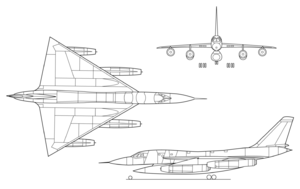
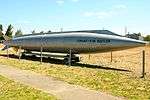
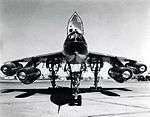
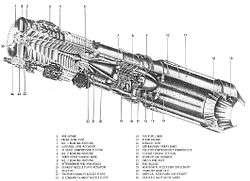
Data from Quest for Performance[65]
General characteristics
- Crew: 3: pilot; observer (navigator, radar operator, bombardier); defense system operator (DSO; electronic countermeasures operator and pilot assistant).
- Length: 96 ft 10 in[66] (29.5 m)
- Wingspan: 56 ft 9 in[66] (17.3 m)
- Height: 29 ft 11 in (8.9 m)
- Wing area: 1,542 ft² (143.3 m²)
- Airfoil: NACA 0003.46-64.069 root, NACA 0004.08-63 tip
- Empty weight: 55,560 lb (25,200 kg)
- Loaded weight: 67,871 lb (30,786 kg)
- Max. takeoff weight: 176,890 lb (80,240 kg)
- Powerplant: 4 × General Electric J79-GE-5A turbojet
- Dry thrust: 10,400 lbf dry thrust (52.9 kN) () each
- Thrust with afterburner: 15,600 lbf (69.3 kN) each
- Zero-lift drag coefficient: 0.0068
- Drag area: 10.49 ft² (0.97 m²)
- Aspect ratio: 2.09
Performance
- Maximum speed: Mach 2.0[66] (1,319mph) at 40,000 ft (12,000 m)
- Cruise speed: 610 mph (530 kn, 985 km/h)
- Combat radius: 1,740 mi (1,510 nmi, 3,220 km)
- Ferry range: 4,100 nmi (4,700 mi, 7,600 km)
- Service ceiling: 63,400 ft (19,300 m)
- Rate of climb: 17,400 ft/min (88 m/s) at gross weight[67]
- Wing loading: 44.0 lb/ft² (215 kg/m²)
- Thrust/weight: 0.919 lbf/lb
- Lift-to-drag ratio: 11.3 (subsonic, "clean configuration")
Armament
- Guns: 1× 20 mm (0.79 in) T171 cannon[66]
- Bombs: 1× B53 or 4× B43 or B61 nuclear bombs; maximum weapons load was 19,450 lb (8,820 kg)
Avionics
- AN/APB-2 Bombing radar[68]
- AN/APN-110 Doppler navigational radar[69] (part of Sperry AN/ASQ-42 Navigation & Bombing System)[70]
- AN/APN-170 Terrain-following radar[69]
- AN/APR-12 Radar warning receiver[71]
- Hughes Aircraft AN/APQ-69 podded Side looking airborne radar (mounted on RB-58A)[72]
- Goodyear AN/APS-73 podded synthetic aperture radar (mounted on RB-58A)[71]
Notable appearances in media
Jimmy Stewart, a bomber pilot during World War II and a brigadier general in the Air Force Reserve, appeared in an Air Force film, flying in the back seat of the B-58 on a typical low-altitude attack in the film B-58 Champion of Champions.[73]
The B-58 has also appeared in the 1964 film Fail-Safe, where stock footage of B-58s was used to represent the fictional "Vindicator" bombers which attacked Moscow. The art used in the original magazine publication of the novel had depicted the "Vindicator" bombers—itself the recycling of the name of a World War II American dive bomber—as almost identical to B-58s but equipped with canards.[74] This would have given the fictional bombers the appearance of the canceled B-58B (see Variants).
In Fail Safe, a 2000 made-for-TV remake starring George Clooney, the fictional Vindicator bomber was again represented by the B-58 Hustler.
See also
- CORDIC algorithm (a digital resolver for Convair's navigation computers CORDIC I and II)
- High Virgo
- Wagtail (missile)
- Related development
- Aircraft of comparable role, configuration and era
- BAC TSR-2
- Boeing XB-59
- Dassault Mirage IV
- Myasishchev M-50
- North American A-5 Vigilante
- Tupolev Tu-22 'Blinder'
- Related lists
References
Notes
- ↑ Knaack, Marcelle Size. Post-World War II Bombers, 1945-1973. Washington, DC: Office of Air Force History, 1988. ISBN 0-16-002260-6.
- ↑ Wilson 2000, p. 38.
- ↑ Martin, Douglas. "Robert H. Widmer, Designer of Military Aircraft, Dies at 95." The New York Times, 2 July 2011.
- ↑ "B-58's Sonic Boom Rattles Kentuckians." Chicago Daily Tribune, 19 December 1961. Retrieved: 2 November 2009.
- ↑ Morrison, David C. (February 1984). "The Weapons Tutorial: Air-Breathing Nuclear Delivery Systems". Bulletin of the Atomic Scientists. 40 (2): 34. Retrieved 30 November 2014.
- 1 2 Miller 1976, p. 24.
- ↑ Miller 1985, p. 26.
- ↑ Miller 1985, p. 28.
- ↑ On display at the Wings Over the Rockies Air and Space Museum.
- ↑ 2008 p. 107.
- ↑ Miller 1985, pp. 53–54.
- ↑ Loftin, Laurence K. Jr. "Quest for Performance: The Evolution of Modern Aircraft. Part II: The Jet Age. Chapter 12: Jet Bomber and Attack Aircraft. Two Pioneering Explorations." National Aeronautics & Space Administration, 2004. Retrieved: 1 December 2014.
- ↑ Miller 1985, p. 94.
- ↑ "Voice warning systems message priority." palaamar.com. Retrieved: 14 September 2015.
- ↑ "Sexy Sally Sounds Off." San Francisco Examiner, 30 July 1966, reprinted in United States Naval Institute Proceedings, November 1966.
- 1 2 3 4 Miller 1985, p. 105.
- ↑ "Convair B-58 Hustler Strategic Bomber." AeroSpaceWeb.org, 2012. Retrieved: 12 December 2014.
- ↑ Miller 1985, p. 109.
- ↑ Miller 1985, p. 39.
- ↑ Miller 1985, p. 42.
- 1 2 Miller 1985, p. 54.
- ↑ Hansen 1988, pp. 158, 161.
- ↑ "Designation systems." designation-systems.net. Retrieved: 8 December 2009.
- ↑ Miller 1985, p. 62.
- ↑ Higham 1975, p. 31.
- ↑ Miller 1985, p. 48.
- ↑ Hall, R. Cargill. "To acquire strategic bombers - The case of the B-58 Hustler." Air University Review, Research Division, at the Albert F. Simpson Historical Research Center, Maxwell AFB, Alabama, September–October 1980. Retrieved: 15 February 2015.
- ↑ Converse 2012, p. 517.
- ↑ Miller 1985, p. 69.
- 1 2 Hall, R. Cargill. "The B-58 Bomber." Air University Review, Research Division, at the Albert F. Simpson Historical Research Center, Maxwell AFB, Alabama, November–December 1981. Retrieved: 14 February 2015.
- ↑ Adams 2009, p. 41.
- ↑ "B-58 Hustler United States Nuclear Forces." FAS.org (Federation of American Scientists, 29 May 1997. Retrieved: 15 February 2015.
- ↑ "B-58 final construction." GlobalSecurity.org, 2015. Retrieved: 15 February 2015.
- 1 2 Slade 2012, p. 238.
- ↑ https://books.google.com/books?id=i03pUlEko8cC&lpg=SA2-PA41&ots=ExbfAkQv4s&dq=B-58%20takeoff%20speed&pg=SA2-PA39#v=onepage&q=B-58%20takeoff%20speed&f=false
- ↑ Sorenson 1995, p. 131.
- ↑ Miller 1985, p. 70.
- ↑ Veronico and Strong 2010, p. 112.
- ↑ Haynes, Leland R. "15,000 Miles Non-Stop in the SR-71 and B-58 Hustler Records Achieved". SR-71 Blackbirds. Leland R. Haynes. Retrieved 14 May 2016.
- ↑ Thomas B. Estes and Dewain C. Vick
- ↑ QUALA MATOCHA. "Former Hillje man holds longest supersonic flight record after 50 years" El Campo Leader News, October 23, 2013. Accessed: December 15, 2013.
- ↑ Comstock, Charles. "The B-58's record flights." 456fis.org (456th Fighter Interceptor Squadron, Seymour Johnson Air Field North Carolina. Retrieved: 2 January 2015.
- ↑ Wayne Thomis, Aviation editor, Chicago Tribune. November 24, 1963.
- ↑ Haynes, Leland R. "B-58 Hustler records & 15,000 miles non-stop in the SR-71." wvi.com (SR-71 Blackbirds), 1996. Retrieved: 12 December 2014.
- ↑ "Trophies won and records set by the B-58." B-58 Hustler Association HomePage. Retrieved: 2 January 2015.
- ↑ Tope, Jessica. "Pope Air Force Base Record Breaking Day." Pope Air Force Base, 12 January 2007. Retrieved: 5 September 2007.
- ↑ Goebel, Greg. "The General Dynamics B-58 & North American XB-70." AirVectors.net, 1 August 2014. Retrieved: 26 January 2015.
- ↑ "Factsheet: Convair B-58B." NationalMuseum.AF.mil (National Museum of the United States Air Force). Retrieved: 26 January 2015.
- ↑ "Convair Super Hustler, Fish & Kingfish." AeroSpaceWeb.org, 2012. Retrieved: 11 December 2014.
- ↑ Hehs, Eric. "Super Hustler, FISH, Kingfish, and Beyond (Part 1: Super Hustler)." CodeOneMagazine.com (Lockheed Martin Aeronautics Company), 15 March 2011. Retrieved: 11 December 2014.
- ↑ Burrows, William E. "The Real X-Jet." AirSpaceMag.com, 1 March 1999. Retrieved: 13 December 2014.
- ↑ "Factsheet: Convair B-58C Hustler." National Museum of the United States Air Force. Retrieved: 5 September 2007.
- ↑ "B-58 Aircraft History - serial numbers and summary." The B-58 Hustler Association. Retrieved: 4 December 2014.
- ↑ Brewer, Randy A. and Alex P. Brewer. "The B-58 Hustler Page - Surviving Inventory." B-58.com, 2014. Retrieved: 18 December 2014.
- ↑ "B-58 Hustler/55-0663." Grissom Air Museum. Retrieved: 4 December 2012.
- ↑ "B-58 Hustler/55-0668." aerialvisuals.ca Retrieved: 4 June 2015.
- ↑ "B-58 Hustler/55-0665." aerialvisuals.ca Retrieved: 20 May 2013.
- ↑ "B-58 Hustler/55-0666." Octave Chanute Aerospace Museum. Retrieved: 4 June 2015.
- ↑ http://www.star-telegram.com/news/local/community/fort-worth/article79617552.html
- ↑ http://www.castleairmuseum.org/b58-hustler
- ↑ "B-58 Hustler/59-2437." aerialvisuals.ca Retrieved 4 June 2015.
- ↑ "B-58 Hustler/59-2458." National Museum of the USAF. Retrieved: 4 December 2012.
- ↑ "B-58 Hustler/61-2059." Strategic Air and Space Museum. Retrieved 4 June 2015.
- ↑ "B-58 Hustler/61-2080." Pima Air & Space Museum. Retrieved: 4 December 2012.
- ↑ Loftin, Laurence K. Jr. "SP-468: Quest for Performance: The Evolution of Modern Aircraft". NASA. Retrieved: 4 April 2006.
- 1 2 3 4 Grant and Dailey 2007, p. 293.
- ↑ Gunston 1986, p. 162.
- ↑ "AN/APA to AN/APD - Equipment Listing." Designation-Systems.net. Retrieved: 3 July 2010.
- 1 2 "AN/APN - Equipment Listing." Designation-Systems.net. Retrieved: 3 July 2010.
- ↑ "AN/ASQ - Equipment Listing." Designation-Systems.net. Retrieved: 3 July 2010.
- 1 2 "AN/APR to AN/APS - Equipment Listing." Designation-Systems.net. Retrieved: 3 July 2010.
- ↑ "AN/APQ - Equipment Listing." Designation-Systems.net. Retrieved: 3 July 2010.
- ↑ "Convair B-58 Hustler, Champion of Champions." YouTube (United States Air Force), 3 December 2014.
- ↑ "1962 ... Failsafe." Flickr, 2015. Retrieved: 16 February 2015.
Bibliography
- Adams, Chris. Deterrence: An Enduring Strategy. New York: IUniverse, Inc., 2009 ISBN 978-1-44016-9786
- Convair B-58 Hustler Pilot's Flight Operating Instructions. Washington, D.C.: United States Air Force, 2008. ISBN 978-0-9816526-5-8.
- Converse, Elliott V. Rearming for the Cold War, 1945-1960 (History of Acquisition in the Department of Defense). Washington, D.C.: Office of the Secretary, Historical Office, 2012. ISBN 978-0-16091-132-3.
- Donald, David and Jon Lake, eds. Encyclopedia of World Military Aircraft. London: AIRtime Publishing, 1996. ISBN 1-880588-24-2.
- Grant, R.G. and John R. Dailey. Flight: 100 Years of Aviation. Harlow, Essex: DK Adult, 2007. ISBN 978-0-7566-1902-2.
- Gunston, Bill. American Warplanes. New York: Crown Publishers Inc., 1986, p. 162. ISBN 0-517-61351-4.
- Gunston, Bill. Bombers of the West. London: Ian Allan Ltd., 1973, pp. 185–213. ISBN 0-7110-0456-0.
- Hansen, Chuck. U.S. Nuclear Weapons: The Secret History. Arlington, Texas: Aerofax, 1988. ISBN 0-517-56740-7.
- Higham, Robin, Carol Williams and Abigail Siddall, eds. Flying Combat Aircraft of the USAAF-USAF (Vol. 1). Andrews AFB, Maryland: Air Force Historical Foundation, 1975. ISBN 0-8138-0325-X.
- Miller, Jay. Convair B-58 Hustler (Aerograph 4). Midland, UK: Aerofax, 1985. ISBN 0-942548-26-4.
- Miller, Jay. "History of the Hustler." Airpower, Vol. 6, No. 4, July 1976.
- Slade, Stuart. United States Strategic Bombers 1945–2012. Newtown, Connecticut: Defense Lion Publications, 2012. ISBN 978-0-5781-0525-3.
- Sorenson, David S. The Politics of Strategic Aircraft Modernization. Westport, Connecticut: Praeger, 1995. ISBN 978-0-2759-5258-7.
- Swanborough, Gordon and Peter M. Bowers. United States Military Aircraft Since 1909. Washington, D.C.: Smithsonian, 1989. ISBN 0-87474-880-1.
- United States Air Force Museum Guidebook. Wright-Patterson AFB, Ohio: Air Force Museum Foundation, 1975.
- Veronico, Nicholas A. and Ron Strong. AMARG: America's Military Aircraft Boneyard. North Branch, Minnesota: Specialty Press, 2010. ISBN 978-1-5800-7139-0.
- Wagner, Ray. American Combat Planes of the Twentieth Century. Reno, Nevada: Jack Bacon and Co., 2004. ISBN 0-930083-17-2.
- Wilson, Stewart. Combat Aircraft since 1945. Fyshwick, ACT, Australia: Aerospace Publications Pty Ltd, 2000, p. 38. ISBN 1-875671-50-1.
- Winchester, Jim, ed. "Convair B-58 Hustler." Military Aircraft of the Cold War (The Aviation Factfile). Rochester, Kent, UK: The Grange plc., 2006. ISBN 1-84013-929-3.
External links
| Wikimedia Commons has media related to B-58 Hustler. |
- (1959) T.O. 1B-58A-1 Flight Manual USAF B/RB-58A Aircraft
- "Champion of Champions (1962)" on YouTube
- B-58 Hustler Association Homepage
- Convair B-58 Hustler Rendezvous
- Aviation-history.com profile of the B-58
- B-58 photographs from the Lockheed Martin Aeronautics Company hosted by the Portal to Texas History
- B-58 Voice Warning Messages
- Offensive Systems and the Pod